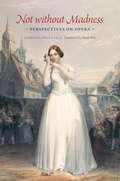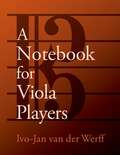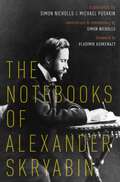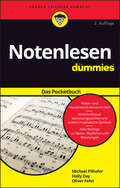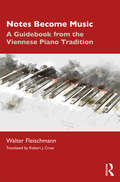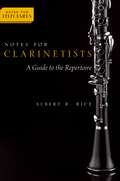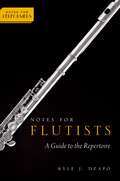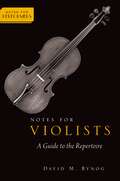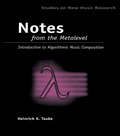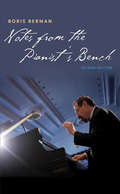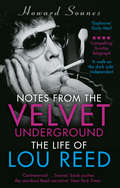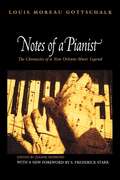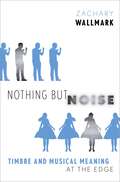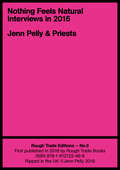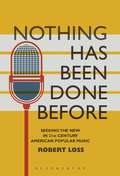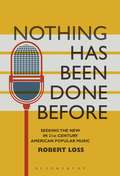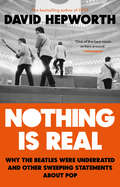- Table View
- List View
Not without Madness: Perspectives on Opera
by Fabrizio Della SetaOpera often seems to arouse either irrational enthusiasm or visceral dislike. Such madness, as Goethe wrote, is indispensable in all theater, and yet in practice, sentiment and passion must be balanced by sense and reason. Exploring this tension between madness and reason, Not without Madness presents new analytical approaches to thinking about eighteenth- and nineteenth-century opera through the lenses of its historical and cultural contexts. In these twelve essays, Fabrizio Della Seta explores the concept of opera as a dramatic event and an essential moment in the history of theater. Examining the meaning of opera and the devices that produce and transmit this meaning, he looks at the complex verbal, musical, and scenic mechanisms in parts of La sonnambula, Ernani, Aida, Le nozze di Figaro, Macbeth, and Il trovatore. He argues that approaches to the study of opera must address performance, interpretation, composition, reception, and cultural ramifications. Purely musical analysis does not make sense unless we take into account music’s dramatic function. Containing many essays available for the first time in English, Not without Madness bridges recent divisions in opera studies and will attract musicologists, musicians, and opera lovers alike.
A Notebook for Viola Players
by Ivo-Jan van der WerffIn A Notebook for Viola Players, Ivo-Jan van der Werff offers a guide to playing the viola with the greatest freedom, dexterity, and ease. It includes right and left hand exercises to build a sound technique, sections on how to practice them, how to hold the viola and bow, how to think about good posture, how to create a good sound, how to play with the least amount of tension, how to deal with anxiety, and thoughts on wellness and practice techniques. Alongside these are photographs and a companion website of video demonstrations of the exercises played by the author, as if in a lesson. Interspersed throughout the book are lively and illuminating anecdotes of van der Werff's own experiences as a student and as a professional musician, as well as a number of blank pages and staff paper for the student to literally 'make notes' and write down their own ideas, offering a space for creative expression using the skills they learn in reading and playing along with the text. Bringing together decades of teaching and performance experience from one of the most respected figures in viola pedagogy, A Notebook for Viola Players is a master class in viola ideal for any player hoping to perfect the fundamental areas of their practice.
A Notebook for Viola Players
by Ivo-Jan van der WerffIn A Notebook for Viola Players, Ivo-Jan van der Werff offers a guide to playing the viola with the greatest freedom, dexterity, and ease. It includes right and left hand exercises to build a sound technique, sections on how to practice them, how to hold the viola and bow, how to think about good posture, how to create a good sound, how to play with the least amount of tension, how to deal with anxiety, and thoughts on wellness and practice techniques. Alongside these are photographs and a companion website of video demonstrations of the exercises played by the author, as if in a lesson. Interspersed throughout the book are lively and illuminating anecdotes of van der Werff's own experiences as a student and as a professional musician, as well as a number of blank pages and staff paper for the student to literally 'make notes' and write down their own ideas, offering a space for creative expression using the skills they learn in reading and playing along with the text. Bringing together decades of teaching and performance experience from one of the most respected figures in viola pedagogy, A Notebook for Viola Players is a master class in viola ideal for any player hoping to perfect the fundamental areas of their practice.
The Notebooks of Alexander Skryabin
by Simon NichollsRussian composer Alexander Skryabin's life spanned the late romantic era and the momentous early years of the twentieth century, but was cut short before the end of the first world war. In a predominantly conservative era in the Russian musical scene, he drew inspiration from poets, philosophers, and dramatists of the Silver Age, a period of radical artistic renewal in Russia. Possessed by an apocalyptic vision of transformation, aspects of which he shared with other Russian thinkers and artists of the period, Skryabin transformed his musical language from a ripe Romantic style into a far-reaching, radical instrument for the expression of his ideas. This newly translated collection of the composer's writings and letters allows readers to experience and understand Skryabin's worldview, personality, and life as never before. The Notebooks of Alexander Skryabin features commentary based on original materials and accounts by the composer's friends and associates, dispelling popular misconceptions about his life and revealing the dazzling constellation of philosophies that comprised his world of ideas, from Ancient Greek and German Idealist philosophy to the writings of Nietzsche, and Indian culture to the Theosophical writings of H. P. Blavatsky. Close textual readings and new biographical insights converge to present a vivid impression of Skryabin's thought and its impact on his musical compositions.
The Notebooks of Alexander Skryabin
by Simon NichollsRussian composer Alexander Skryabin's life spanned the late romantic era and the momentous early years of the twentieth century, but was cut short before the end of the first world war. In a predominantly conservative era in the Russian musical scene, he drew inspiration from poets, philosophers, and dramatists of the Silver Age, a period of radical artistic renewal in Russia. Possessed by an apocalyptic vision of transformation, aspects of which he shared with other Russian thinkers and artists of the period, Skryabin transformed his musical language from a ripe Romantic style into a far-reaching, radical instrument for the expression of his ideas. This newly translated collection of the composer's writings and letters allows readers to experience and understand Skryabin's worldview, personality, and life as never before. The Notebooks of Alexander Skryabin features commentary based on original materials and accounts by the composer's friends and associates, dispelling popular misconceptions about his life and revealing the dazzling constellation of philosophies that comprised his world of ideas, from Ancient Greek and German Idealist philosophy to the writings of Nietzsche, and Indian culture to the Theosophical writings of H. P. Blavatsky. Close textual readings and new biographical insights converge to present a vivid impression of Skryabin's thought and its impact on his musical compositions.
Notenlesen für Dummies Das Pocketbuch: Das Pocketbuch (Für Dummies)
by Michael Pilhofer Holly Day Oliver FehnSpielen Sie mit dem Gedanken, ein Instrument zu erlernen? Oder sind Sie schon seit Jahren passionierter Gitarrist, der wunderbar nach Tabulaturen spielt, bei Notenblättern jedoch kapituliert? In jedem Fall werden Sie Ihr musikalisches Potenzial enorm erhöhen, wenn Sie die Sprache der Musik beherrschen. Dieses Buch erklärt Ihnen leicht verständlich, was es mit Noten- und Pausenwerten auf sich hat, welche anderen Symbole wichtig sind und was Sie über Rhythmus und Co. wissen müssen. Die neue Auflage wurde um praktische Übungen erweitert.
Notes Become Music: A Guidebook from the Viennese Piano Tradition
by Walter FleischmannNotes Become Music: A Guidebook from the Viennese Piano Tradition addresses the many unwritten nuances of dynamics, articulation and agogics as an expression of fundamental principles of a common European musical language. It treats the score as an incomplete musical shorthand that outlines the compositional and interpretive imperatives implicit within it, drawing on historical records from the eighteenth and nineteenth centuries and detailed comparisons of works to underline the author’s presentation of Viennese tradition. This book is not primarily concerned with questions of style or interpretation. Rather, it explains the many facets of musical notation that were taken for granted by composers who assumed a knowledge of the piano tradition of their day. Notes Become Music informs not only those students in countries where the central European music tradition is still unfamiliar, but also a younger generation of Europeans who have grown up without a living connection to their musical past.
Notes Become Music: A Guidebook from the Viennese Piano Tradition
by Walter FleischmannNotes Become Music: A Guidebook from the Viennese Piano Tradition addresses the many unwritten nuances of dynamics, articulation and agogics as an expression of fundamental principles of a common European musical language. It treats the score as an incomplete musical shorthand that outlines the compositional and interpretive imperatives implicit within it, drawing on historical records from the eighteenth and nineteenth centuries and detailed comparisons of works to underline the author’s presentation of Viennese tradition. This book is not primarily concerned with questions of style or interpretation. Rather, it explains the many facets of musical notation that were taken for granted by composers who assumed a knowledge of the piano tradition of their day. Notes Become Music informs not only those students in countries where the central European music tradition is still unfamiliar, but also a younger generation of Europeans who have grown up without a living connection to their musical past.
Notes for Clarinetists: A Guide to the Repertoire (Notes for Performers)
by Albert R. RiceNotes for Clarinetists: A Guide to the Repertoire offers important historical and analytical information about thirty-five of the best-known pieces written for the instrument. Numerous contextual and theoretical insights make it an essential resource for professional, amateur, and student clarinetists. With engaging prose supported by fact-filled analytical charts, the book offers rich biographical information and informative analyses to help clarinetists gain a more complete understanding of Three Pieces for Clarinet Solo by Igor Stravinsky, Aaron Copland's Concerto for Clarinet, String Orchestra, Harp, and Piano, Robert Schumann's Fantasy Pieces for Clarinet and Piano, Op. 73. and Time Pieces for Clarinet and Piano, Op. 43. by Robert Muczynski, among many others. With close attention to matters of context, style, and harmonic and formal analysis, Albert Rice explores a significant portion of the repertoire, and offers a faithful and comprehensive guide that includes works by Boulez, Brahms, and Mozart to Hindemith, Poulenc, and Stamitz. Rice includes biographical information on each composer and highlights history's impact on the creation and performance of important works for clarinet. Intended as a starting point for connecting performance studies with scholarship, Rice's analysis will help clarinetists gain a more complete picture of a given work. Its valuable insights make it essential to musicians preparing and presenting programs, and its detailed historical information about the work and composer will encourage readers to explore other works in a similarly analytical way. Covering concertos, chamber pieces, and works for solo clarinet, Rice presents Notes for Clarinetists as an indispensable handbook for students and professionals alike.
Notes for Clarinetists: A Guide to the Repertoire (Notes for Performers)
by Albert R. RiceNotes for Clarinetists: A Guide to the Repertoire offers important historical and analytical information about thirty-five of the best-known pieces written for the instrument. Numerous contextual and theoretical insights make it an essential resource for professional, amateur, and student clarinetists. With engaging prose supported by fact-filled analytical charts, the book offers rich biographical information and informative analyses to help clarinetists gain a more complete understanding of Three Pieces for Clarinet Solo by Igor Stravinsky, Aaron Copland's Concerto for Clarinet, String Orchestra, Harp, and Piano, Robert Schumann's Fantasy Pieces for Clarinet and Piano, Op. 73. and Time Pieces for Clarinet and Piano, Op. 43. by Robert Muczynski, among many others. With close attention to matters of context, style, and harmonic and formal analysis, Albert Rice explores a significant portion of the repertoire, and offers a faithful and comprehensive guide that includes works by Boulez, Brahms, and Mozart to Hindemith, Poulenc, and Stamitz. Rice includes biographical information on each composer and highlights history's impact on the creation and performance of important works for clarinet. Intended as a starting point for connecting performance studies with scholarship, Rice's analysis will help clarinetists gain a more complete picture of a given work. Its valuable insights make it essential to musicians preparing and presenting programs, and its detailed historical information about the work and composer will encourage readers to explore other works in a similarly analytical way. Covering concertos, chamber pieces, and works for solo clarinet, Rice presents Notes for Clarinetists as an indispensable handbook for students and professionals alike.
Notes for Flutists: A Guide to the Repertoire (Notes for Performers)
by Dr. Kyle DzapoNotes for Flutists: A Guide to the Repertoire offers important historical and analytical information about three dozen of the best-known pieces written for the instrument. Its contextual and theoretical insights make it an essential resource for professional, amateur, and student flutists. With engaging prose supported by fact-filled analytical charts, the book offers rich biographical information and informative analyses to help flutists gain a more complete understanding of J. S. Bach's Sonata in B minor, Reinecke's Undine Sonata, Fauré's Fantaisie, Hindemith's Sonata for Flute and Piano, Copland's Duo for Flute and Piano, and 30 other masterpieces. Offering a faithful and comprehensive guide to understanding the contexts in which the repertoire was composed, Notes for Flutists details in clear, chronological order flute repertoire from Telemann, Mozart, and Enescu to Prokofiev, Poulenc, and Muczynski. Kyle Dzapo includes biographical information on each composer and highlights history's impact on the creation and performance of important works for flute. Intended as a starting point for connecting performance studies with scholarship, Dr. Dzapo's analysis will help flutists gain a more complete picture of a given work. Its valuable insights make it essential to musicians preparing and presenting programs, and its detailed historical information about the work and composer will encourage readers to explore other works in a similarly analytical way. Covering concertos, chamber pieces, and works for solo flute, Kyle Dzapo presents Notes for Flutists, an indispensable handbook for students and professionals alike.
Notes for Flutists: A Guide to the Repertoire (Notes for Performers)
by Dr. Kyle DzapoNotes for Flutists: A Guide to the Repertoire offers important historical and analytical information about three dozen of the best-known pieces written for the instrument. Its contextual and theoretical insights make it an essential resource for professional, amateur, and student flutists. With engaging prose supported by fact-filled analytical charts, the book offers rich biographical information and informative analyses to help flutists gain a more complete understanding of J. S. Bach's Sonata in B minor, Reinecke's Undine Sonata, Fauré's Fantaisie, Hindemith's Sonata for Flute and Piano, Copland's Duo for Flute and Piano, and 30 other masterpieces. Offering a faithful and comprehensive guide to understanding the contexts in which the repertoire was composed, Notes for Flutists details in clear, chronological order flute repertoire from Telemann, Mozart, and Enescu to Prokofiev, Poulenc, and Muczynski. Kyle Dzapo includes biographical information on each composer and highlights history's impact on the creation and performance of important works for flute. Intended as a starting point for connecting performance studies with scholarship, Dr. Dzapo's analysis will help flutists gain a more complete picture of a given work. Its valuable insights make it essential to musicians preparing and presenting programs, and its detailed historical information about the work and composer will encourage readers to explore other works in a similarly analytical way. Covering concertos, chamber pieces, and works for solo flute, Kyle Dzapo presents Notes for Flutists, an indispensable handbook for students and professionals alike.
Notes for Violists: A Guide to the Repertoire (Notes for Performers)
by David M. BynogNotes for Violists: A Guide to the Repertoire offers historical and analytical information about thirty-five of the best-known pieces for the instrument, making it an essential resource for professional, amateur, and student violists alike. With engaging prose supported by fact-filled analytical charts, the book offers rich biographical information and insightful analyses that help violists gain a more complete understanding of pieces like Béla Bartók's Concerto for Viola and Orchestra, Rebecca Clarke's Sonata for Viola and Piano, Robert Schumann's Märchenbilder for Viola and Piano, op. 113, Carl Stamitz's Concerto for Viola and Orchestra in D Major, Igor Stravinsky's Élégie for Viola or Violin Unaccompanied, and thirty other masterpieces. This comprehensive guide to key pieces from the viola repertoire from the eighteenth through the twentieth century covers concertos, chamber pieces, and works for solo viola by a wide range of composers, including Bach, Telemann, Mozart, Hoffmeister, Walton, and Hindemith. Author David M. Bynog not only offers clear structural analyses of these compositions but also situates them in their historical contexts as he highlights crucial biographical information on composers and explores the circumstances of the development and performance of each work. By connecting performance studies with scholarship, this indispensable handbook for students and professionals allows readers to gain a more complete picture of each work and encourages them to approach other compositions in a similarly analytical manner.
Notes for Violists: A Guide to the Repertoire (Notes for Performers)
by David M. BynogNotes for Violists: A Guide to the Repertoire offers historical and analytical information about thirty-five of the best-known pieces for the instrument, making it an essential resource for professional, amateur, and student violists alike. With engaging prose supported by fact-filled analytical charts, the book offers rich biographical information and insightful analyses that help violists gain a more complete understanding of pieces like Béla Bartók's Concerto for Viola and Orchestra, Rebecca Clarke's Sonata for Viola and Piano, Robert Schumann's Märchenbilder for Viola and Piano, op. 113, Carl Stamitz's Concerto for Viola and Orchestra in D Major, Igor Stravinsky's Élégie for Viola or Violin Unaccompanied, and thirty other masterpieces. This comprehensive guide to key pieces from the viola repertoire from the eighteenth through the twentieth century covers concertos, chamber pieces, and works for solo viola by a wide range of composers, including Bach, Telemann, Mozart, Hoffmeister, Walton, and Hindemith. Author David M. Bynog not only offers clear structural analyses of these compositions but also situates them in their historical contexts as he highlights crucial biographical information on composers and explores the circumstances of the development and performance of each work. By connecting performance studies with scholarship, this indispensable handbook for students and professionals allows readers to gain a more complete picture of each work and encourages them to approach other compositions in a similarly analytical manner.
Notes from the Metalevel: An Introduction to Computer Composition
by Heinrich TaubeFirst Published in 2005. Routledge is an imprint of Taylor & Francis, an informa company.
Notes from the Metalevel: An Introduction to Computer Composition
by Heinrich TaubeFirst Published in 2005. Routledge is an imprint of Taylor & Francis, an informa company.
Notes from the Pianist's Bench: Second Edition, Multimedia Edition
by Boris BermanA master class on piano performance and pedagogy from the world-renowned concert pianist In this newly revised edition of a comprehensive guide to piano technique, performance, and music interpretation, renowned performing musician, recording artist, and teacher Boris Berman addresses virtually every aspect of musical artistry and pedagogy. Ranging from such practical matters as sound, touch, and pedaling to the psychology of performing and teaching, this essential volume provides a master class for the performer, instructor, and student alike. It is also available as a multimedia e-Book.
Notes from the Velvet Underground: The Life of Lou Reed
by Howard Sounes**** COMPELLING - The Sunday TelegraphCONTROVERSIAL ... Sounes' book pushes the standard Reed narrative - The New York TimesLou Reed, who died in 2013, was best known to the general public as the grumpy New Yorker in black who sang 'Walk on the Wild Side'. To his dedicated admirers, however, he was one of the most innovative and intelligent American songwriters of modern times, a natural outsider who lived a tumultuous and tortured life.In this in-depth, meticulously researched and very entertaining biography, respected biographer Howard Sounes examines the life and work of this fascinating man, from birth to death, including his time as the leader of The Velvet Underground - one of the most important bands in rock'n'roll.Written with a deep knowledge and understanding of the music, Sounes also sheds entirely new light on the artist's creative process, his mental health problems, his bisexuality, his three marriages, and his addictions to drugs and alcohol.In the course of his research, Sounes has interviewed over 140 people from every part of Lou Reed's life - some of whom have not spoken publicly about him before - including music industry figures, band members, fellow celebrities, family members, former wives and lovers.This book brings Lou Reed and his world alive.
Notes of a Pianist
by Louis Moreau Gottschalk Jeanne Behrend Frederick S. StarrNotes of a Pianist chronicles the life of one of the most remarkable musical minds of the American experience, the great nineteenth-century New Orleans-born composer and pianist Louis Moreau Gottschalk (1829-1869). An important cultural and historical work, the book recounts Gottschalk's experiences as he traveled and performed throughout the last decade of his life. Born to an English-Jewish father and a Haitian mother, Gottschalk is remembered as one of the great New Orleans musicians and composers, his music a combination of the classical tradition in which he was trained, and the New Orleans tradition into which he was born. His art form took him far outside the boundaries of Louisiana, however. While still a child, he studied piano in Paris and gave a concert at the Salle Pleyel, after which Frédéric Chopin is said to have remarked: "Give me your hand, my child; I predict that you will become the king of pianists." Gottschalk returned to the United States in 1853, and later lived in Cuba, Puerto Rico, Panama, and South America, during which time he kept-sometimes sporadically, sometimes daily--the notebooks that formed the basis of Notes of a Pianist. Published for the first time in 1881, the book continues to resonate with American cultural and musical life. Notes of a Pianist demonstrates Gottschalk's importance not only as a reporter of the musical life and tastes of Americans during the Civil War, but also as a forefather of Louisiana's rich musical culture.
Nothing but Noise: Timbre and Musical Meaning at the Edge
by Zachary WallmarkNothing but Noise: Timbre and Musical Meaning at the Edge explores how timbre shapes musical affect and meaning. Integrating perspectives from musicology with the cognitive sciences, author Zachary Wallmark advances a novel model of timbre interpretation that takes into account the bodily, sensorimotor dynamics of sound production and perception. The contribution of timbre to musical experience is clearest in drastic situations where meaning is itself contested; that is, in polarizing contexts of reception where evaluation of "musical" timbre by some listeners collides headlong against a competing claim-that it is just "noise." Taking this ubiquitous moment as a starting point, the book explores affect, reception, and timbre semantics through diverse cultural-historical case studies that frustrate the acoustic and perceptual boundary between musical sound and noise. Nothing but Noise includes chapters on the racial and gender politics in the reception of free jazz saxophone "screaming" in the late 1960s; an analysis of contested timbral ideals in the performance practices of the Japanese shakuhachi flute; and an historical examination of the overlooked role of "brutal" timbres in the moral panic over heavy metal in the eighties and nineties. The book closes with a discussion of the slippery social fault lines separating perceptions of musical sound from noise and the ethical stakes of encountering another's "aural face."
Nothing but Noise: Timbre and Musical Meaning at the Edge
by Zachary WallmarkNothing but Noise: Timbre and Musical Meaning at the Edge explores how timbre shapes musical affect and meaning. Integrating perspectives from musicology with the cognitive sciences, author Zachary Wallmark advances a novel model of timbre interpretation that takes into account the bodily, sensorimotor dynamics of sound production and perception. The contribution of timbre to musical experience is clearest in drastic situations where meaning is itself contested; that is, in polarizing contexts of reception where evaluation of "musical" timbre by some listeners collides headlong against a competing claim-that it is just "noise." Taking this ubiquitous moment as a starting point, the book explores affect, reception, and timbre semantics through diverse cultural-historical case studies that frustrate the acoustic and perceptual boundary between musical sound and noise. Nothing but Noise includes chapters on the racial and gender politics in the reception of free jazz saxophone "screaming" in the late 1960s; an analysis of contested timbral ideals in the performance practices of the Japanese shakuhachi flute; and an historical examination of the overlooked role of "brutal" timbres in the moral panic over heavy metal in the eighties and nineties. The book closes with a discussion of the slippery social fault lines separating perceptions of musical sound from noise and the ethical stakes of encountering another's "aural face."
Nothing Feels Natural: Interviews in 2016 (Rough Trade Edition)
by Jenn Pelly PriestsNothing Feels Natural is an abridged editions of the zine that originally accompanied Priests' debut LP of the same name in 2017. It features a series of interviews conducted with the band by journalist Jenn Pelly in Washington, DC during the first days of November 2016.
Nothing Has Been Done Before: Seeking The New In 21st-century American Popular Music (Alternate Takes: Critical Responses To Popular Music Ser.)
by Professor Robert LossIs there such a thing today as music that's meaningfully new? In our contemporary era of remixing and retro styles, cynics and romantics alike cry "It's all been done before" while record labels and media outlets proclaim that everything is new. Coded into our daily conversations about popular music, newness as an artistic and cultural value is too often taken for granted.Nothing Has Been Done Before instigates a fresh debate about newness in American pop, rock 'n' roll, rap, folk, and R&B made since the turn of the millennium. Utilizing an interdisciplinary approach that combines music criticism, philosophy, and the literary essay, Robert Loss follows the stories of a diverse cast of musicians who seek the new by wrestling with the past, navigating the market, and speaking politically. The transgressions of Bob Dylan's "Love and Theft". The pop spectacle of Katy Perry's 2015 Super Bowl halftime show. Protest songs against the war in Iraq. Nothing Has Been Done Before argues that performance heard in a historical context always creates a possibility for newness, whether it's Kendrick Lamar's multi-layered To Pimp a Butterfly, the Afrofuturist visions of Janelle Monáe, or even a Guided By Voices tribute concert in a local dive bar. Provocative and engaging, Nothing Has Been Done Before challenges nothing less than how we hear and think about popular music-its power and its potential.
Nothing Has Been Done Before: Seeking the New in 21st-Century American Popular Music (Alternate Takes: Critical Responses to Popular Music)
by Robert LossIs there such a thing today as music that's meaningfully new? In our contemporary era of remixing and retro styles, cynics and romantics alike cry "It's all been done before" while record labels and media outlets proclaim that everything is new. Coded into our daily conversations about popular music, newness as an artistic and cultural value is too often taken for granted.Nothing Has Been Done Before instigates a fresh debate about newness in American pop, rock 'n' roll, rap, folk, and R&B made since the turn of the millennium. Utilizing an interdisciplinary approach that combines music criticism, philosophy, and the literary essay, Robert Loss follows the stories of a diverse cast of musicians who seek the new by wrestling with the past, navigating the market, and speaking politically. The transgressions of Bob Dylan's "Love and Theft". The pop spectacle of Katy Perry's 2015 Super Bowl halftime show. Protest songs against the war in Iraq. Nothing Has Been Done Before argues that performance heard in a historical context always creates a possibility for newness, whether it's Kendrick Lamar's multi-layered To Pimp a Butterfly, the Afrofuturist visions of Janelle Monáe, or even a Guided By Voices tribute concert in a local dive bar. Provocative and engaging, Nothing Has Been Done Before challenges nothing less than how we hear and think about popular music-its power and its potential.
Nothing is Real: The Beatles Were Underrated And Other Sweeping Statements About Pop
by David HepworthPop music’s a simple pleasure. Is it catchy? Can you dance to it? Do you fancy the singer?What’s fascinating about pop is our relationship with it. This relationship gets more complicated the longer it goes on. It’s been going on now for 50 years.David Hepworth is interested in the human side of pop. He’s interested in how people make the stuff and, more importantly, what it means to us. In this wide-ranging collection of essays, he shows how it is possible to take music seriously and, at the same time, not drain the life out of it. From the legacy of the Beatles to the dramatic decline of the record shop, from top tips for bands starting out to the bewildering nomenclature of musical genres, with characteristic insight and humour, he explores the highways and byways of this vast multiverse where Nothing Is Real and yet it is, emphatically and intrinsically so. Along the way he asks some essential questions about music and about life: is it all about the drummer; are band managers misunderstood; and is it appropriate to play ‘Angels’ at funerals?As Pope John Paul II said ‘of all the unimportant things, football is the most important’. David Hepworth believes the same to be true of music and this selection of his best writing, covering the music of last fifty years, shows you precisely why.
